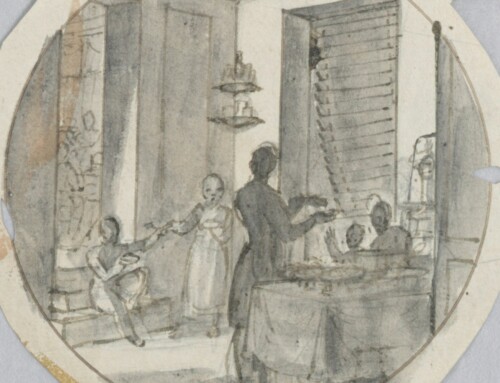As a child I was somewhat mystified by my mother’s liking for century eggs, a Chinese delicacy known also as thousand-year eggs or Ming Dynasty eggs or pi dan. I did not find them to be delicious, was at a loss to describe the taste, and then just filed it under the category of acquired tastes (click here for a brief description of how century eggs are made). Other newcomers to eating century eggs have better clarity. In Eve Curie’s book Journey Among Warriors (1943), a collection of her work as a war correspondent during World War II, she remarks on page 363 that such eggs at a meal in the city of Chengdu (China) tasted like Roquefort cheese.
Another case in which a food tastes like Roquefort cheese without actually being Roquefort cheese is that of a soybean cheese made in imitation of Roquefort. In 1881 France, the August 10th edition of the Parisian newspaper Le XIXe siècle reported that a Dr. Picard had experimented with soybeans to make a successful “simili-roquefort.” In 1911 Paris, a soybean version of Roquefort appeared on the menu for the annual luncheon of the Société d’Acclimatation (click here to see the menu). In “Etudes sur la caséine végétale du ‘soja’ et ses applications” by Francis J.-G. Beltzer, an article written for the June 10th edition of the Revue scientifique in 1911, the author lists three main varieties of “fromage végétal” from the territory of Annam: one that tastes like Roquefort, another that is similar to goat cheese, and a third that has aspects of Gruyère. In 1917 and 1918, several newspapers across the United States noted that Dr. Yamei Kin (1864-1934) had created a faux Roquefort during her research on how to make better meals for American soldiers by using soybeans.

Extrait. “Chronique Scientifique.” Le XIXe siècle : journal quotidien politique et littéraire, 10 August 1881, p. 2. Bibliothèque nationale de France → https://gallica.bnf.fr/ark:/12148/bpt6k7579958n/f2.image.r=roquefort%20fromage%20soja?rk=107296;4

Extrait. “Au Grand-Palais, s’est ouvert le quatrième Salon du Mobilier.” Le Journal (Paris), 12 August 1911, p. 3. Bibliothèque nationale de France → https://gallica.bnf.fr/ark:/12148/bpt6k76279510/f3.image.r=roquefort%20fromage%20soja?rk=171674;4

Walter Richard Sickert (1860-1942). Roquefort. Circa 1918/1919 – 1920. Public Domain. Wikiart → https://www.wikiart.org/en/walter-sickert/roquefort . See also the Tate (UK) → https://www.tate.org.uk/art/research-publications/camden-town-group/walter-richard-sickert-roquefort-r1129546

Century Eggs from China. 21 January 2008. FotoosVanRobin from Netherlands, CC BY-SA 2.0 <https://creativecommons.org/licenses/by-sa/2.0>, via Wikimedia Commons. → https://commons.wikimedia.org/wiki/File:Four_century_eggs.jpeg
▀▄▀▄▀▄
References & Suggested Reading
Aoyagi, Akiko, and William Shurtleff. Biography of Yamei Kin M. D. (1864-1934), (Also Known as Jin Yunmei), the First Chinese Woman to Take a Medical Degree in the United States, 2nd Ed: Extensively Annotated Bibliography and Sourcebook. United States, Soyinfo Center, 2016.
“Au Grand-Palais, s’est ouvert le quatrième Salon du Mobilier.” Le Journal (Paris), 12 August 1911, p. 3.
Barrau, Fernand de. “La situation agricole dans l’Aveyron : La fève de soja ; Lait et fromage de soja.” Journal d’agriculture pratique, 6 July 1911, pp. 21-22.
Beltzer, Francis J.-G. “Etudes sur la caséine végétale du ‘soja’ et ses applications.” Revue scientifique, 10 June 1911, pp. 716-720.
“Chronique agricole. Un lait végétal : Lait de Soja. — Fromage de Soja. — Aurons-nous bientôt le Roquefort de Soja ? Craintes vaines.” La Croix de l’Aveyron : organe hebdomadaire des intérêts religieux, agricoles et démocratiques, 7 July 1911, p. 1.
“Chronique Scientifique.” Le XIXe siècle : journal quotidien politique et littéraire, 10 August 1881, p. 2.
Curie, Eve. Journey Among Warriors. New York: Doubleday, Doran and Co., Inc., 1943.
Dunlop, Fuchsia. “Transforming Eggs in Chinese Culinary Culture.” Eggs in Cookery: Proceedings of the Oxford Symposium of Food and Cookery 2006, edited by Richard Hosking, Prospect Books, 2007, pp. 54-59.
Ives, Mike. “Overlooked No More: Yamei Kin, the Chinese Doctor Who Introduced Tofu to the West.” The New York Times. 17 October 2018.
Loyer, Maurice. “Déjeuner amical annuel de la Société d’Acclimatation.” Bulletin de la Société nationale d’acclimatation de France : revue des sciences naturelles appliquées, Société nationale d’acclimatation de France (Paris), 1911, pp. 764-767.
MacDougal, Sarah. “Introducing to America an entirely new food—The soy bean: Dr. Yamei Kin (Document part II).” The Bean-Bag (St. Louis, Missouri), St. Louis Post-Dispatch Sunday Magazine. 17-19 October 1918.
– – – . “The soy bean’s many aliases: An artistic and appetizing demonstration of the many-sidedness of a 2,000-year-old Chinese vegetable that is meat, fish, milk, butter, cheese and many more in one.” San Antonio Light (Texas). 6 October 1918, p. 44.
“Makes new kind of meat.” Davis County Clipper (Utah), 26 February 1918, p. 7.
“Makes new kind of meat.” Express (Monticello, Iowa), 25 July 1918, p. 3.
Roth, Matthew. “The Chinese-Born Doctor Who Brought Tofu to America.” Smithsonian Magazine, 13 August 2018, https://www.smithsonianmag.com/history/chinese-born-doctor-who-brought-tofu-america-180969977/
Shurtleff, William, and Akiko Aoyagi. History of International Trade in Soybeans, Soy Oil and Soybean Meal, Plus Trade Policy (1859-2021): Extensively Annotated Bibliography and Sourcebook. United States, Soyinfo Center, 2021.
Sieber, Karen. “Dr. Kin Yamei, the Chinese immigrant experience, and the future of tofu.” Theodore Roosevelt Center at Dickinson State University, 27 April 2019, https://www.theodorerooseveltcenter.org/Blog/Item/Dr.%20Kin%20Yamei,%20the%20Chinese%20immigrant%20experience,%20and%20the%20future%20of%20tofu
Swingle, Walter T. “Our Agricultural Debt to Asia.” The Asian Legacy and American Life, edited by Arthur E. Christy, The John Day Co., 1945, pp. 84-114.
“Woman off to China as Government Agent to Study Soy Bean: Dr. Kin Will Make Report for United States on the Most Useful Food of her Native Land.” The New York Times, 10 June 1917, p. 9.




